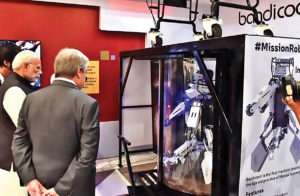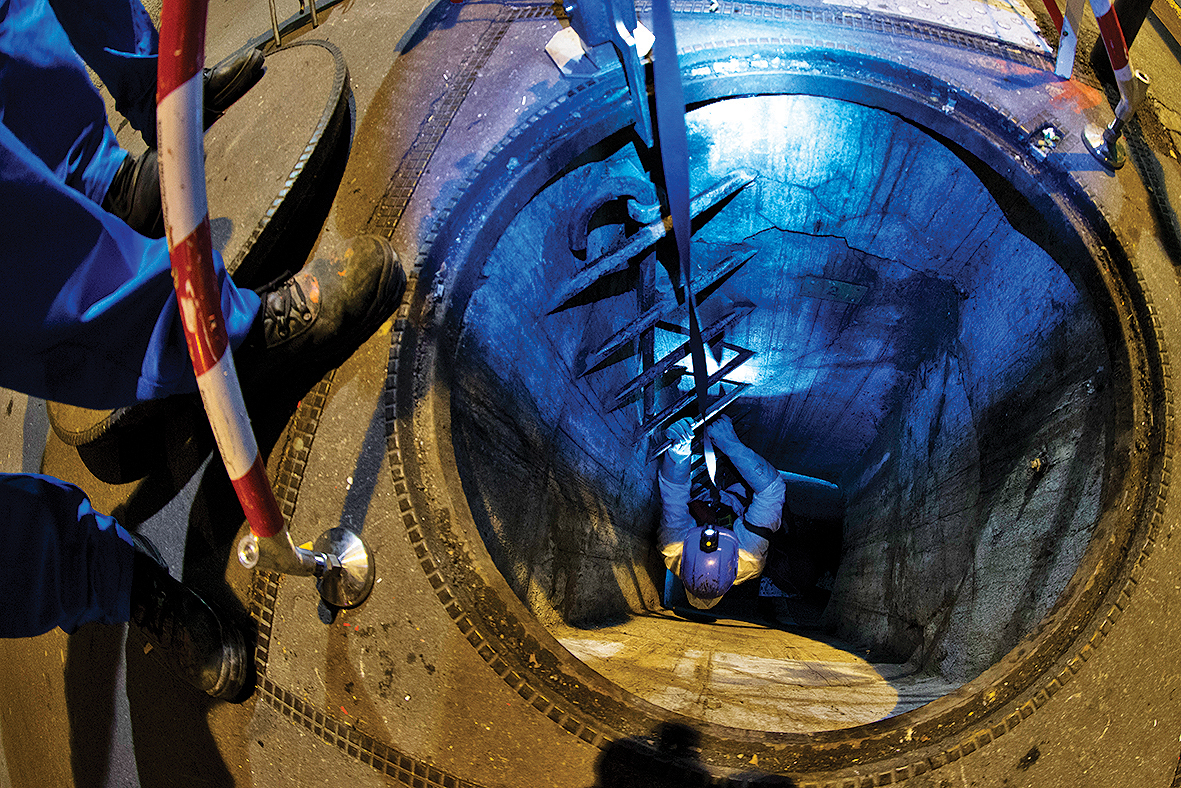The law against manual scavenging allows contractors to send workers into tanks with gear, and only during emergencies. But this is still being done as part of a regular cleaning routine. How many more deaths will it take for the authorities to stop this practice?
“Every time a death happens, it shakes us up, and makes us take more precautions and follow safety procedures. It’s scary to see another person dying from the same profession,” says Mohit (name changed), 23, a sewage worker.
The sun’s scorching heat is squeezing out all the energy from commuters present on the road in front of Karkardooma Metro Station in East Delhi. Almost everyone is either standing in the shade, or walking briskly to avoid staying in the heat for too long.
Amid the busy road in front of the station, three huge trucks are parked, covering half of the lane, due to their width. These trucks belong to Delhi Jal Board — the agency which looks after sewage treatment in the city, besides water treatment.
Mohit picks up the call, his voice muffled and echoing. When asked the reason, he replies, “Main tank mein hoon. Safai chal rahi hai.” (I’m inside the tank. Cleaning is in process).
The tank is a sewage tank — home to poisonous gases, which time and again have taken several lives in Delhi. Twenty-five deaths since 2018.
Mohit calls up again, and tells Patriot that he’s looking to reach a place which is “safe,” out of sight of the contractor. As the eyes search for Mohit to come out from the group of workers standing behind the three trucks, another call comes and gets disconnected instantly. A few seconds later, he arrives.
Wearing a yellow industrial helmet and casual clothes, he’s panting as the heat makes it unbearable for him to even gasp out a greeting. With him is his nephew Anwar (name changed), 27, another sewage worker.
Both the persons find a shade to talk with skepticism writ large on their faces. “What is it about? Why are you here? Did we do something wrong?” asks Anwar.
The reason for his worry is the contractor, who is “not behaving with us very nicely these days. If he gets to know about this (interview), then we can be in trouble.” The contractor, the workers say “is always on our heads, which is understandable, but our reasons for not having high regard for him now is strictly because he doesn’t talk to us properly,” says Mohit.
Mohit and Anwar work for a company which they don’t want to name — to keep their employment with the company intact. The company gets projects for sewage cleaning from Delhi Jal Board and municipal corporations too.
They are told about the hundreds of death which have happened due to manual scavenging. Anwar agrees that it “it is a pressing issue and gets us worried, but what else can we do if not this?”
Both of them hail from Malda district in the northern part of West Bengal, from the same family. While Mohit got a job through the recommendation of his uncle, who worked for years in Delhi before settling Mohit in his place, Anwar joined the profession later.
Both earn Rs 18,000 a month, spending about Rs 3,000-4,000 on their own upkeep and send the rest to their family in Malda in West Bengal.

Anwar is far more experienced than Mohit, because of his age, but the way he speaks about his work, doesn’t suggest that he’s proud of it.
Mohit affirms that he “never wanted to do this kind of work.” The change in his life, from sewing sportswear to cleaning tanks, speaks of the plight he is in today and the frustration he feels about his current job.
The workers live erratically wherever the project is in progress. These days, they are living in Mayur Vihar Phase 3, in a shelter which the Delhi Jal Board uses for the stay of the workers.
Prohibition of Employment as Manual Scavengers and their Rehabilitation Act 2013 prohibits the employment of any person as a manual scavenger. However, a big loophole screams out of the Act — they can be deployed in emergency situations.
Why does manual scavenging still exist? Because the law allows it, provided proper gear is used. The 2013 Act speaks of employment of people for manual scavenging, but only if they’re provided the gear and that too in emergency situations.
The Act doesn’t actually say that a person should not be sent into a tank. This is why municipal corporations across the country send hundreds of persons inside septic tanks.
The fact that the Delhi Jal Board employs people like Mohit and Anwar is proof that the law is not effective in its stated aim to end the deadly practice of manual scavenging across the country.
And it’s not just the Delhi Jal Board, but NDMC (North Delhi Municipal Corporation) too. Mohit and Anwar were first found by Patriot when Mohit was working at Shahjahan Road in central Delhi.
In the lush Lutyens Delhi, where the top brass of many sectors live, right in the middle of the road, Mohit was seen overlooking the work which was in progress — to clean the manholes along the road.
Mohit and Anwar say that both the NDMC and the Delhi Jal Board use a vacuum pipe which sucks out the dirty water, which is then transferred to the connected truck.
Since all the deaths have happened due to asphyxiation, Mohit and Anwar assure that they have “never ever been through such a situation.”
They tell, that each time a work is in progress to clean up a tank, there’s a device which shows the toxicity of the gas inside the tank, and not until it is under the safe radar, they are asked to go inside.
Even for the masks, Anwar very excitedly tells that anyone who has to go inside the tank, has to “wear the mask in front of the supervisor and check if it’s tight enough, so that there’s no chance of air coming from outside the mask.”
And while they are in the tank, two fans — one inside and one outside, are there to keep the air flow going smoothly, as they hold the suction pipe for hours. They also confirm that from gloves to boots to helmet, everything is provided on duty by the Delhi Jal Board.
This process alone takes up to three hours. And no mistake about it, it’s a “tiring process.” Both the persons do an 8-hour shift without any holidays.
Anwar tells that if he wishes to go and see his family in West Bengal, the contractor cuts the salary. “There are no paid holidays, except national ones.”
In the middle of the conversation, Mohit speaks of how everything is okay except being underpaid and how he wishes to go back to sewing sportswear, as he used to in a factory in Kapashera in South West Delhi. Because “it’s better work and clean work. And I felt good doing it. This work doesn’t give you any respect, and is considered low-class work in our society.”
Anwar too, jumps in the conversation and tells that he has applied for a driver’s license, which is stuck in the process “due to elections.” But he hopes that he gets it soon, so that he can drive a vehicle, instead of cleaning tanks. “It will also give Rs 2,000 more than my current salary,” he adds.
They credit their awareness of safety measures to the deaths they know have happened in the past. “If ever we notice that there’s some danger to our lives, we will back out. Life is more important than anything else,” says Anwar.
Anwar who has a one-year-old son, aspires to send him to school. He adds, “because I didn’t go to school, I have to rely on this kind of work. But if my son goes to school and does well in studies, then definitely I would not like him to be even remotely close to this profession.”
By the end of the conversation, there was a gleam of hope in both the persons’ eyes — of switching to alternative careers. Which suggests that both, even with gear, abhor the practice of scavenging, even if it’s automated.
The very existence of Mohit and Anwar in this profession, raises a question about the claims of 200 sewer cleaning machines which the Delhi government boasted about in March.
It is also truly sad that every death due to manual scavenging reminds them to be more cautious of their work, rather than reforms in the law, which can drastically improve the quality of work and life.
The idea was inspired from a Robot named Bandicoot, developed by Kerala-based start-up Genrobotics, that has been commissioned by municipal bodies in Kerala, Tamil Nadu and Andhra Pradesh. About 80 manual scavengers have been trained in these states to operate the robots in a bid to offset the loss of livelihood.





